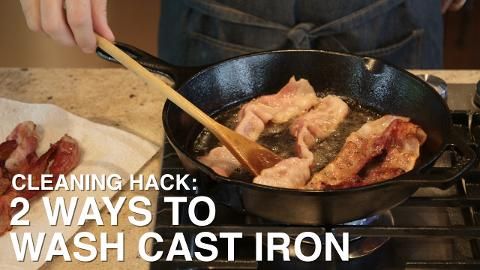You can look for them in thrift stores among the old toasters and cut-glass candy dishes—or in flea markets next to stacks of Fiestaware and grandmothers’ discarded doilies. At estate sales you’ll find them among the decorative gelatin molds and specialty pans—if you can find them at all. A decade ago, before the whole country realized how valuable they were, vintage cast-iron pans were easy to find, purchased by only those who already prioritized slow cooking over speed and convenience. Now hunting down an old cast-iron pan can feel like looking for an uncut diamond. But if you keep an eye out and are patient, you can still find a great one.
Related: Make Your Favorite Skillet Last Forever
When I first began cooking, I bought two cast-iron pans off the shelf and then spent years wondering why anyone advocated for them. They were heavy and unwieldy, my seasoning never really produced a nonstick surface, and I could never get my food to brown and flip evenly. Then when I was home one holiday and cooking with my mom’s one and only 11-inch cast-iron skillet, I noticed that hers was noticeably different. While mine were heavy, hers was sturdy but light. Where mine had rough, almost pebbly cooking surfaces, hers was completely smooth. The color of her pan even seemed lighter, and she didn’t need as many layers of oil to get a non-stick surface. That’s when I learned that my mother’s pan is vintage, a flea-market find she picked up for a song in the late ’70s, just a year or two before I was born. The pan was better because it had been made better, and that quality was palpable. (Keep any eye out for these eight invaluable things you should always buy at the thrift store.)
Vintage cast iron skillets were made with much more care and craftsmanship than those that are produced today.
Doing some research, I learned that vintage cast-iron skillets and Dutch ovens from the 19th and early 20th centuries were made with much more care and craftsmanship than those produced today. These pots and pans were made by hand: Sand molds were carefully formed, and the iron was hand-poured, allowing manufacturers to make thinner, lighter cookware than can be made in a factory. And the pans were also finished to make their surfaces smoother; they could be polished with a grinding stone or “milled” to make the bottom of the pan completely flat and smooth (a process that removed more metal than grinding), and some companies also used proprietary finishing techniques to make “mirror polished” or “frosted” pans that had an almost satin feel. These methods made the pans easier to handle and to season—and, therefore, to cook with.
Now I’m always on the hunt for vintage cast-iron pans. Over the years, I’ve learned to look for a few things: First, the best cast iron was made in the U.S., and most of what is still available today was made by just nine companies: Birmingham Stove & Range, Favorite Stove & Range, Griswold Manufacturing, Lodge Manufacturing, Martin Stove & Range, Sidney Hollow Ware, Vollrath Manufacturing, Wagner Manufacturing, and Wapak Hollow Ware. Many of these companies made cookware under a few different brand names, and many continued to produce wares after they’d switched over to an automated manufacturing process. Lodge, for instance, still makes high-quality pans today. But if their names are stamped anywhere on the pan, or if you can find the name of the city the foundry was in, it’s a good start. (The term “Made in the U.S.A” wasn’t stamped on pans until after automated manufacturing became the norm. If you see this, it’s not vintage.) (Cast-iron isn't the only thing you purchase buy secondhand—check out these nine things you should always buy used.)
Second, I check to see if the pan is chipped, warped, or has any pitting or hairline fractures. A pan with a bad patina can be reseasoned, but structural problems cannot be fixed. Mostly, I look at the quality of the pan. Does it feel light and is easy to handle? Does the metal look sturdy but thin? Does the surface feel smooth? On some high-quality pans you will still see the whorls or concentric circles made by milling and polishing. (Keep your vintage cast iron in great shape by avoiding these eighteen mistakes that can ruin your cast-iron pans.)
If you really fall in love with cast-iron pans, you can join a whole world of collectors who are out there hunting for unusual items, like waffles irons, muffin pans, or camp ovens (a kind of Dutch oven with feet). These aficionados memorize the locations of the best foundries and the ways the companies’ logos changed over the years. Some have even learned how to identify items without visible names.
But for me, this process is much simpler—I’m just wanting to find pans I can cook with, that will hold and distribute heat well, that will develop a shiny nonstick surface over time, and will last for many years—so that I can pass them on to my daughter someday.













